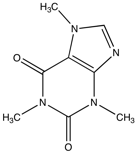Phantastica






Between a morning cup of coffee, an afternoon mug of tea, a post-work chocolate snack, and a bottle of soda with dinner, most people consume some form of caffeine on a daily basis. In fact, caffeine is the most highly used psychoactive substance in the world; nearly all of this caffeine is consumed via food and beverage, and most of it is from coffee and tea. Americans consume an average of 168 mg of caffeine, or 3,7-dihydro-1,3,7-trimethyl-1h-purine-2,6-dione, per day (worldwide average is approximately 70 mg/day), and 143 mg of that was from coffee! Additionally, caffeine is quite unique because, although mildly addictive, there have been no governmental controls placed on the use or sale of caffeine (Fredholm, 1999).
Caffeine consumption was first recorded around 2700 B.C. in China when Emperor Shen Nung drank brewed tea. Coffee, however, did not appear until 575 A.D. in Africa. Coffee has been traded and enjoyed since then, but was not popularly drank in the United States until the 18th century, when colonists chose it over the heavily taxed tea. Caffeinated soda was introduced around 1880, but it wasn’t until 1958 that the American Food and Drug Administration recognized caffeine as “Generally Recognized as Safe” (Chrisholm, 2009).
Caffeine works on the central nervous system in multiple ways, and research has been done to identify the many reasons that it has such a marked effect on the body (Fredholm, 1999). The primary action of caffeine is to block, or antagonize, adenosine receptors. Adenosine works to slow brain function (to protect the brain), and some adenoside recepotors are proposed to be connected to dopamine receptors. These two functions explain the excitatory response elicited by caffeine (Fredholm, 1999). Some other secondary actions that caffeine has on the CNS are as follows. It inhibits phosphodiesterases, which are responsible for breaking down cAMP, leading to increased function of the cAMP second messenger. Caffeine increases entry of Ca2+ into cells; Ca2+ is important in neurotransmission and muscle contraction. Finally, caffeine binds to GABA receptors at the benzodiazepine site. In humans, GABA is one of the main neurotransmitters responsible for excitatory response (Whittem, 1999).
Caffeine has been related to many other systems of the body and has been claimed to be both health-promoting and health-damaging. Here, effects on the heart, and sleep cycle will be very briefly discussed. When consumed, caffeine can cause the heart to palpitate, and decrease in heart rate; a rapid rise in blood pressure is also observed. These effects, however, are decreased or eliminated once caffeine tolerance builds up within two or three days (Fredholm, 1999). In regard to sleep, about 200 mg is needed (when consumed close to bedtime) to affect sleep. When someone takes this dose, they notice decreased sleep quality, shortened sleep time, increase in light sleep EEG stages, and decreases in deep sleep EEG stages (Fredholm, 1999). Caffeine has effects on other areas of the body as well (such as mood, locomotion, and cognitive performance), but more research is currently happening to better explain why all of these responses are triggered.

caffeine
References
Caffeine [Internet]: Demand Media, Inc.; c2009 [cited 2009 November 25]. Available from: http://www.livestrong.com/article/14111-caffeine/.
Fredholm BB, Battig K, Holmen J, Nehlig A, Zvartau EE. 1999. Actions of caffeine in the brain with special reference to factors that contribute to its widespread use. Pharmacological Reviews 51(1): 83-125.
Caffeine Vault [Internet]: Erowid; c1999 [cited 2009 November 25]. Available from
“Decaffeinated coffee is kind of like kissing your sister.”
- Bob Irwin
Monday, November 30, 2009


Caffeine






